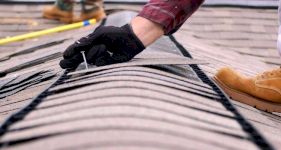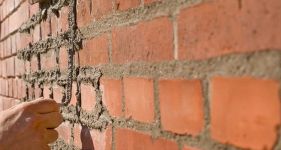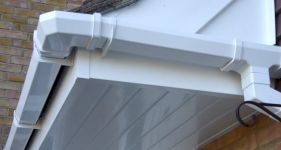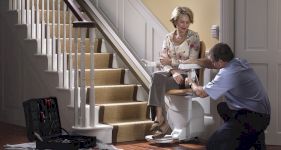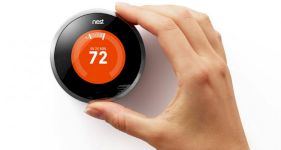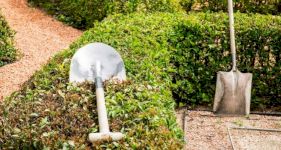Artificial Grass Installation Cost
- The average artificial grass installation cost is around £2,000 in the UK.
- It typically takes between 1 and 2 days to lay fake grass.
- A breakdown of the cost of laying artificial grass, including artificial grass costs per m² for different quality materials and the typical fake grass installation cost in 2025.
- The pros and cons of different types of artificial turf, what's involved in artificial grass installation, and how long it tends to take.
- How to find and hire an artificial grass installer near you.
Looking into how much artificial grass and astroturf costs in the UK?
Artificial grass prices in 2025 range between £55–£75 per m² (including installation/labour fees) or £5 and £20 per m² for materials only. The price of artificial grass varies significantly depending on the type and quality of fake grass you want to get, with premium options looking and feeling more realistic than cheaper options.
We cover everything you need to know in this artificial grass price guide. This includes what different types and grades of fake grass cost, how much it costs to lay artificial grass, and much more.
Ready to get a quote?
We've got a variety of local artificial grass installers that would be happy to give you a free, no obligation quote!
Want to find out more first?
Continue reading below for all the details on artificial and astroturf prices in the UK!
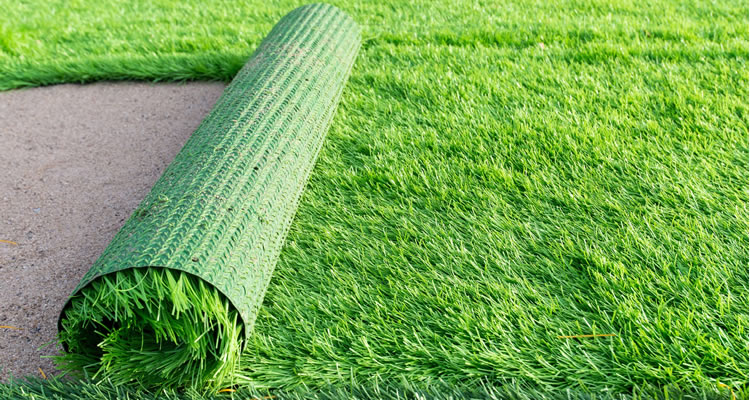
£2,000
Table of Contents
- How Much Is Artificial Grass?
- Calculate Artificial Grass Installation Cost
- How Much to Lay Artificial Grass?
- How Much Does Artificial Grass Cost?
- Additional Artificial Grass Installation Costs
- What Impacts Artificial Grass Installation Costs?
- What's Involved in Laying Artificial Grass?
- What Is Artificial Grass?
- What Are the Benefits of Artificial Grass?
- How to Install Artificial Grass
- What Type of Artificial Grass Should I Use?
- Artificial Grass Alternatives
- Maintaining and Repairing Artificial Grass
- What is the Best Time of Year to Install Artificial Grass?
- Is Artificial Grass Bad for the Environment?
- Cost of Artificial Grass Removal
- Checklist: Hiring an Artificial Grass Installer
How Much Is Artificial Grass?
How much will it cost to install artificial grass in your garden?
Well, average costs can vary depending on the size of your garden and the type of grass chosen to install.
The price for a small garden (measuring approximately 12m by 3m) would begin at around £400 and can increase to £1,500. This price does include material and labour costs, although costs in London and South East England are usually higher due labour costs and additional delivery charges.
What about costs for an average sizes garden?
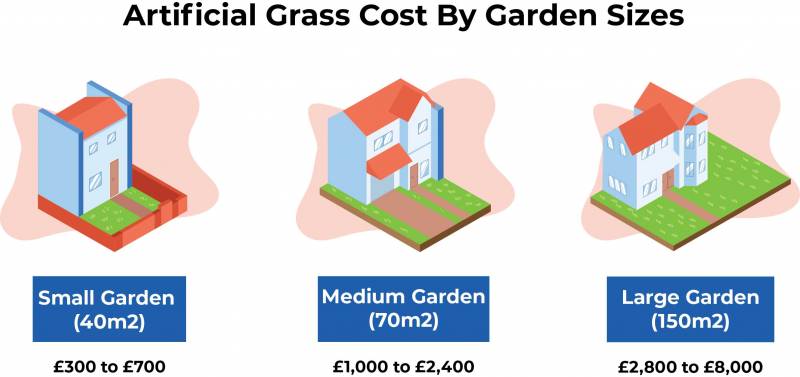
For the average sized UK garden (of around 70m²) the prices begin at around £800 and increase to just over £3,500.
What does the overall cost depend on?
The size of your garden, intended use, and the quality of the artificial grass chosen will all affect the final price.
Labour costs will also affect the final budget required; however, this will vary with the length of time installation takes, as the majority of grasses are installed following the same method.
Prices of Artificial Grass
Here are some artificial grass prices:
Basic Artificial Grass Price
If on a fixed-budget, basic quality artificial grass is the cheapest and most cost-effective choice.
So, how much does basic quality cost?
Starting prices for basic versions of artificial grass (not including labour fees) begin as low as £5 per m² and can increase to £9.99 per m², depending on the thickness of the weave and level of realism required.
As a result, for a standard small garden measuring around 40m², with fitting, the material alone will cost around £200 to £400 and once labour costs were included would amount to around £300 to £500.
Also, fitting artificial grass within a small 40m² garden should only take a single day to complete.
I'm considering having artificial grass fitted. If I want artificial grass that is relatively cheap but still long-lasting, what type should I consider purchasing?
Medium Quality Artificial Grass Price
The most commonly purchased style of artificial grass is the medium quality.
How much does medium quality cost?
The material only price for medium quality begins at around £9.99 per m² and increases to £19.99 per m², depending on the realism required, the thickness of the weave, and the materials used in the construction of the chosen style.
For example, a standard UK garden measuring 70m², including fitting, would cost around £700 to £1,400 for the materials, and increase to around £900 to £1,600 with labour costs.
The average time for this type of installation will usually take around 2 days to complete.
Premium Quality Artificial Grass Price
Premium is one of the best quality and long-lasting styles available on the market!
What are the benefits of premium artificial grass?
Providing an extremely realistic look and feel, with nearly zero of the downside real grass comes with: Premium is the recommended choice for a great-looking and long-lasting alternative to real grass.
Is premium artificial grass expensive?
Premium artificial grass prices (not including installation) range from around £25 to £45 per m², depending on the realism required, length of the grass required, thickness of the weave, materials used in construction, and intended use for the final product.
For example, laying premium artificial grass in a standard medium-sized garden (70m²), the material alone will cost around £2,000 to £2,800, and once the cost of fitting is added, would usually be £2,500 to £3,200. The average time for the installation will usually take around 2 days to complete.
Elite Quality Artificial Grass Price
The highest quality artificial grass on the market is known as Elite. Much as the name suggests, it has no rival when it comes to the realistic appearance and feel.
Elite quality grass is often confused with real grass and only on extremely close inspection can be identified as artificial, even by the sharpest eyes.
However, with the extremely high level of quality comes a price tag to match, material only prices often beginning at around £50 per m² reaching costs of over 50m².
There is a wide range of different styles within the elite bracket, with almost every species of real grass having an artificial version available.
Let's take a look at overall costs...
The material costs alone for an average size (70m²) garden will cost around £3,500 to £7,000, and once fitting costs are included, will usually increase to around £3,800 to £7,300. The average time for the installation will, like most of the other styles, usually take around 2 days to complete.
With all the costs included, the biggest two factors that will affect the cost are the number of square meters and the quality of the finish. The below table analysis several scenarios, alongside the duration required and estimated total cost (including materials and labour fees).
| Job Description | Duration | Estimated Total Cost |
|---|---|---|
| Small Garden (40m²) with Basic Artificial Grass | 1 day | £300 |
| Small Garden (40m²) with Medium Artificial Grass | 1 day | £700 |
| Medium Garden (70m²) with Basic Artificial Grass | 2 day | £1,000 |
| Medium Garden (70m²) with Medium Artificial Grass | 2 days | £1,350 |
| Medium Garden (70m²) with Premium Artificial Grass | 2 days | £2,400 |
| Medium Garden (70m²) with Elite Artificial Grass | 2 days | £3,800 |
| Large Garden (150m²) with Medium Artificial Grass | 4 days | £2,800 |
| Large Garden (150m²) with Premium Artificial Grass | 4 days | £5,000 |
| Large Garden (150m²) with Elite Artificial Grass | 4 days | £8,000 |
Calculate Artificial Grass Installation Cost
Check out our artificial grass cost calculator to find out how much it costs to lay fake grass in your specific circumstances.
How Much to Lay Artificial Grass?
Costs of Hiring Tradesmen
When hiring any tradesman for building work, you need to consider what specific jobs actually need doing, as not all tradesmen can handle the same types of work. Laying artificial grass would often be undertaken by a single landscape gardener.
However, a carpet fitter could be considered for the job, as the skills are often transferable. Also, when considering the hiring of a carpet fitter, artificial grass is often purchased from a carpet store. As a result, the store will often offer fitting within the purchase price of the grass.
Landscape Gardener Cost
The most common tradesman to hire for any garden work would be the landscape gardener. As a result, when deciding to fit artificial grass in your garden, this will probably be your first thought. It can, however, be an expensive choice to hire a landscaper, at around £100 to £125 per day. However, an average-sized garden at around 70m² will only take around 2 days to complete.
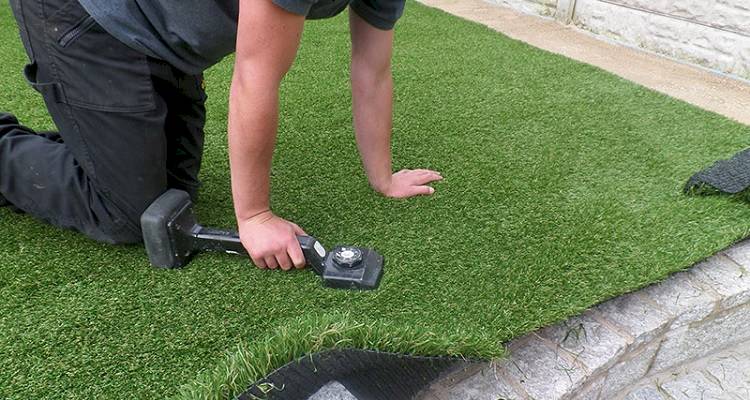
Carpet Fitter Cost
Fitting artificial grass is often a similar process to fitting a carpet, just performed outside. Therefore, an often-overlooked tradesman is a carpet fitter.
A carpet fitter will usually cost around £90 to £100 per day to hire, depending on experience and level of skill. Always check that they're happy to take on the job of laying your artificial grass before asking for a quote.
Labourer Cost
The most inexpensive form of tradesman, a labourer, while not commonly used in laying artificial grass within a property, should not be overlooked when costing the job. Usually, a specialist will provide their own personal labourer, but you should be mindful of the costs to hire them.
The day rate of a simple labourer will usually be £50 to £60 per day. They are used for all the heavy lifting work, moving materials, and jobs, which do not require a specific skill.
Timescales
One of the most important factors to consider when deciding to install artificial grass is the timescale required to complete the job, as it directly impacts the final cost. The longer the installation takes, the more you’ll pay in labour fee.
The overall timescale will depend on several factors, including the size and condition of your garden, along with any preperation needed to remove obstacles and such like. If the grass requires rainage or weed membrane can also affect how long the job takes, and the experience of the tradesperson may also plays a role.
The following provides estimated installation times by garden size:
- Small garden (40m²): 1–2 days
- Medium garden (70m²): 2–3 days
- Large garden (150m²): 4–5 days
The following rates are based on the average tradesmen cost for a job estimated to take between 1 to 4 days to complete.
| Tradesman | Cost per Day | Total Labour Cost |
|---|---|---|
| Landscape Gardener | £125 | £125 - £500 |
| Carpet Fitter | £100 | £100 - £400 |
| Labourer | £50 | £50 - £200 |
How Much Does Artificial Grass Cost?
The supply cost for laying artificial grass in a garden will vary slightly depending on your choice of grass style. Beyond the obvious grass layer, the fixture method, weed membrane, bottom layer, and any specialist care equipment can also affect the price.
Artificial Grass Cost Per M²
The layer of artificial grass itself is obviously the most important material to purchase for the project. Depending on the style chosen to lay, this can be formed from three main materials: nylon, polypropylene, and polyethylene.
Nylon Artificial Grass Cost
Nylon is often chosen for its superior strength and resilience, making it perfect for high-impact and abrasive sporting pitches.
The price of nylon grass usually begins at around £9.99 per m² and can increase to around £39.99 per m², though it will not appear as realistic as its counterparts.
Due to the complicated process and expensive base materials, out of the three materials, nylon has the highest initial cost when used for artificial grass. Nylon grass is, therefore, often used solely in high-traffic, high-wear environments such as commercial applications.
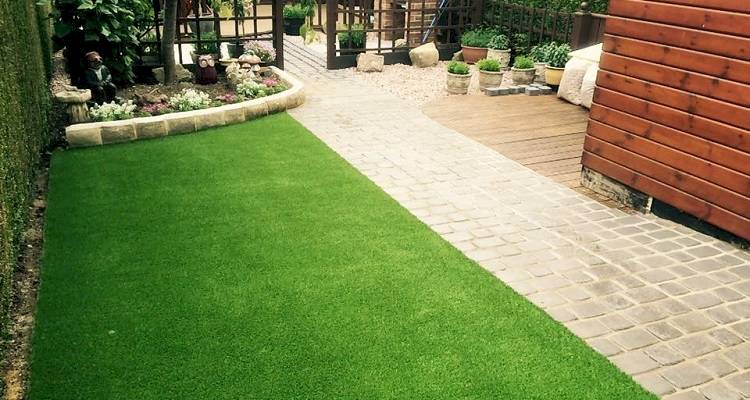
Polypropylene Artificial Grass Cost
With a moderate to high level of toughness and abrasion resistance, polypropylene has become a popular material in the production of budget-friendly artificial grass.
The prices of polypropylene grass begin around £9.99 per m² and increase to around £29.99 per m², depending on the thickness of the grass, lengths of strands, and underlay used in its construction.
However, this cost-effective option can have a lack of realism due to its reflective and polished finish, which can also make it potentially slippery while in wet conditions.
Polyethylene Artificial Grass Cost
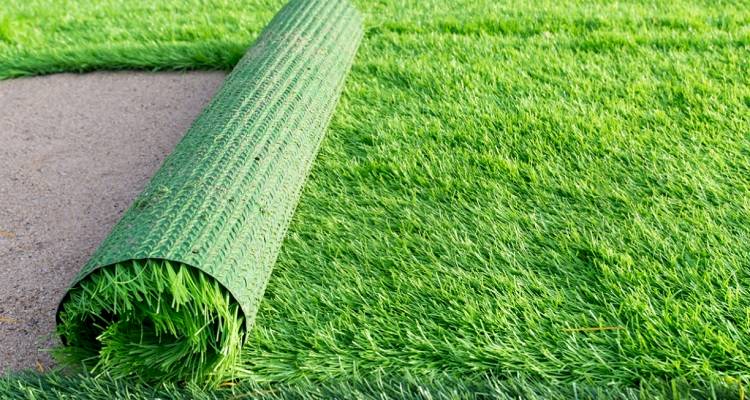
Polyethylene is more expensive than polypropylene, however, is often well-balanced in termss of softness and abrasion-resistant strength. Seen as a good "all-rounder" it has grown in popularity within the artificial grass marketplace.
Beginning at around £20 per m² for average quality grass and increasing to £50 per m² for the most realistic varieties, polyethylene is quickly becoming the gold standard for artificial grass.
Underlay Material Cost
Sand
When laying artificial turf in a garden, if the ground is now level and flat, it may require the addition of a sand layer. On average, a medium-sized garden (70m²) will take around one ton of sand to cover with a few inches of layer height.
Sand is not a very expensive material, so affordable builder’s grade sand will only cost around £50 per ton.
Weed Membrane
In order to keep the artificial grass area weed-free and therefore reduce the amount of maintenance required to keep it looking clean, tidy, and new, a weed membrane is nearly always required.
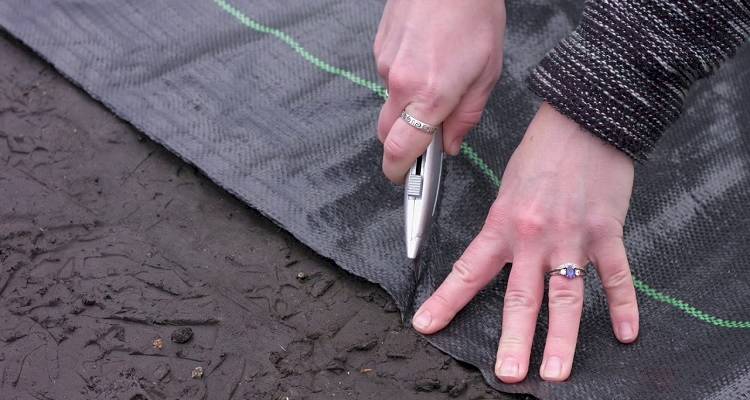
These will begin at around £12 per m² for a quality, long lasting, and resilient variety, however more cost effective, budget friendly, versions are available beginning at around £5 per m². These membranes are laid below the artificial grass and are usually the second action performed after the space is dug out and levelled.
Joining/Fixing Materials Cost
Joining Tape
Due to the fact artificial grass comes in rolls, it is often required to use joining tape to fix the edges together and create a seamless area. Self-adhesive joining tape is the simplest way to bond the two edges of artificial grass strips without the need for additional glue.
The price of joining tapes usually begin at around £1.20 per metre, and can increase to around £20 for a 5m roll of high-quality tape.
Two-Part Bonding Adhesive
Grass Adhesive is sold as a two-part adhesive system designed for bonding artificial grass backing directly to any stable subfloor. This is often only used when laying artificial grass on a solid floor, such as concrete.
Costing around £50 per 10kg tub, this would provide enough glue to cover a medium-sized garden at around 70m².
Galvanised Steel U-pins
At 16cm long, steel U-pins are the most common method used for securing artificial grass to soft surfaces, such as dirt, gravel, or sand. It is standard practice to attach 1 pin to every 0.5m² of grass.
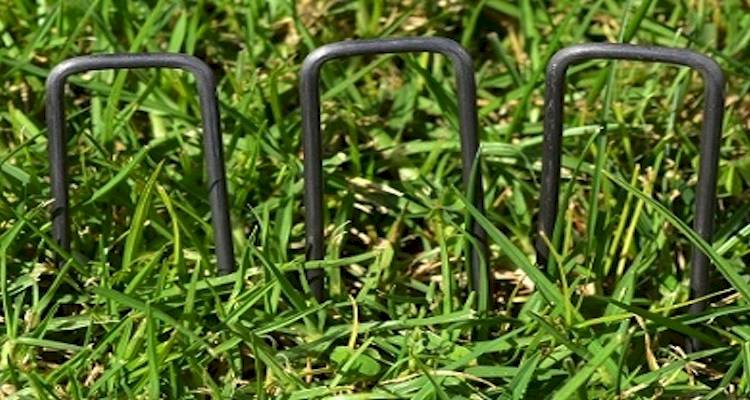
Pins are often supplied in packs of 10, and prices begin at £5 per pack. Therefore, for a medium garden measuring 70m², you will require around 20 packs, costing you £100.
Is it possible to lay artificial grass on concrete?
Additional Artificial Grass Installation Costs
Gardener Cost
While installing artificial grass doesn't require as much regular maintenance as real turf, you may still need to look into hiring a gardener if you intend to keep the rest of your outside space looking good.
Gardeners tend to charge around £14 to £25 depending on experience, or they may quote for a one off job if you need to have some initial gardening work carried out before laying the new artificial grass.
Landscaping Cost
After an artificial lawn has been completed, it may be a good idea to hire a landscaper to redo the rest of the external area of your property. From flowerbeds to fences and general borders, a landscaper can help assist in designing the perfect look for your garden.
The cost of garden landscaping is around £150 per day for an experienced specialist.
However, if you have already hired the landscaper to lay the fake grass, you may be able to arrange a discounted service in order to complete any further work required outside.
New Garden Fence Cost
If you want to improve your garden's security, adding a new garden fence is a great option. The average cost of replacing a garden fences is around£1,500, depending on the size of your property. Higher prices for premium materials, such as metal, cost more but can look very sleek and modern alongside an artificial lawn.
New Garden Wall Cost
Perhaps you'd like something more long-lasting than a garden fence that will stand the test of time against harsh winds? If so, ensure your new garden wall before having the new artificial grass installed.
Building a garden brick wall costs on average around £1,000 and can be installed in around 3 days, again depending on the size of your garden.
New Patio Cost
If installing artificial grass is part of a larger garden overhaul, why not consider adding an area of patio so you can sit back and relax in the summer sun? New patio installation costs £1,200, taking around 2 days to be complete.
You can choose from concrete for durability, stone for a natural-looking aesthetic, or even gravel for a cheap and easy option.
What Impacts Artificial Grass Installation Costs?
There are several factors that can impact the installation cost of laying artifical grass. As well as your location and the fees charged by your chosen company or independant labourer, you should also consider the following.
Labour and Material Costs
The cost of labour usually takes the largest chunk out of your building budget. However, the cost of artificial grass will vastly outweigh any other costs during the project.
Additional materials such as adhesives, membranes, sand, and fixture pins will often only take up a fraction of the budget in comparison. The grass material easily surpasses the price of labour when higher quality styles are selected for the installation.
Quality of the final appearance factors into the final cost of an artificial lawn greatly. For a medium garden (70m²) with a full lawn completed, if basic quality non-realistic grass is used, costs will begin at around £800 to £900.
However, for the same property, yet with premium quality grass with a realistic finish (such as Amalfi grass at £25.99 per m²), it would increase the price to around £2,000.
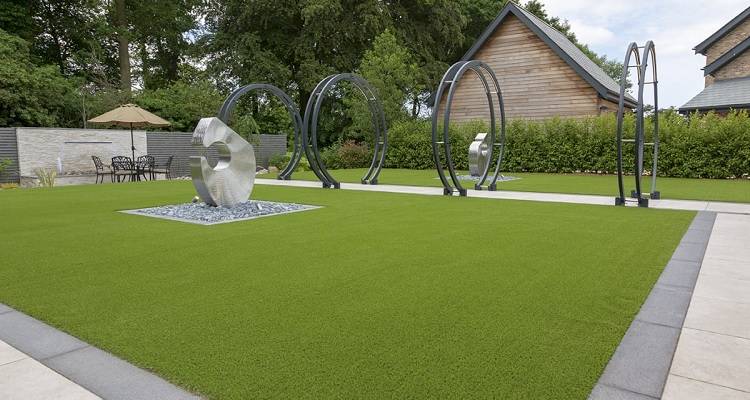
Waste Disposal and Skip Hire
Another cost to account for is the disposal of waste after completing the installation. Waste disposal will usually consist of simply hiring a skip.
Skip hire costs around £200 to £250 for a single skip hired for a week, although this can be higher in areas such as London and the South East. Included in the price of the hire is usually the cost of collection and disposal of the waste, although there may be an additional fee of £15 to £60 if you require a permit from your local council.
Garden Clearance and Preparation
Finally, if your property has a garden in an extremely poor state or wildly overgrown, it will need to be cleared before the new lawn can be laid. This will create a demand for landscape gardeners at a considerable cost.
It is therefore common for people planning to install an artificial grass area to first clear the garden themselves. This will usually involve simply pulling and cutting back any plants, digging out any shrubs or bushes, and removing any existing grass lawns themselves.
If, however, a professional is required, this will often cost around £150 per day (or more if skip hire is also needed) and, depending on the level of work and size of the garden, can take up to 3 days to complete.
What's Involved in Laying Artificial Grass?
Budgeting
Removing Existing Turf and Plants
Preparing the Base Layer for Installation
Laying the Artificial Grass
Holding-Down the Grass and Making Sure the Joining Line is Not Visible
Adding Sand as an Infill
Enjoying Your New Lawn
The first step is going to be planning a budget. This is a very important step, as there is no point in starting a project you cannot afford to complete it.
Factors such as materials, labour, and additional expenses need to be calculated at this stage. This includes working out how much it costs to cover the desired area in your selected artificial grass.
The first task to complete is to remove all the existing turf (if there is any) from the chosen site of your new lawn. A standard garden spade will work well for small jobs up to around 40m².
However, using a spade for a larger garden (70m²+) would become tedious - in this case, you would be better off hiring a turf cutter (at around £50 per day). It is normally required that a depth of around 100mm (4 inches) is dug out of the area to be covered.
Next, you will need to decide if you are laying a hard or soft base layer for the artificial turf to be attached to.
If a hard surface is chosen, the cement, gravel or sand should be laid and then compacted with a whacker-plate (hired for around £50 per day).
If a soft layer has been chosen, then a layer of levelling sand should be laid, and a weed membrane fitted to the area.
Once the area has been prepared and is ready, it is time to actually lay the grass down. First, you should carefully measure the area to be covered, then (if you have not done so already) purchase the correct size of grass needed to cover the chosen area.
Next, with a tape measure and a sharp knife, cut the rolls of grass to fit neatly within the edges of the area. You must use precise and clean cutting strokes to ensure you do not end up with straggly, unsightly edges. It is also extremely important to make sure each roll is laid in the same direction, as this will create a more attractive and even final result.
You will now need to join the edges of the rolls together. For this task, it is common practice to use turf joining tape (or, if attaching to a hard surface, "two-part adhesive bonding glue"). You should pay special attention not to allow the edges to overlap or the fibres of the grass to get entangled within the tape.
It is common for artificial grass that is being used to move around in the place it is laid - for this reason, it is often best to attach it to the area in which it has been laid. Securing the grass firmly to the base layer is often performed via pins or glue (depending on soft or hard underlay). Pinning should be performed every 0.5m section to allow the strongest possible hold.
You must also be extremely careful to make sure there are no visible gaps between roll sections. To create an invisible seam, special attention and care should be used when cutting the edges to ensure a straight and clean line. This is accomplished with the use of a brand-new sharp Stanley knife blade.
After the layer of artificial turf has been laid, it is often a great idea to spread a layer of sand over the top to create an "infill". This can usually be performed by simply sprinkling the sand on the top of the grass and then using a common broom to work the grains into the grass itself. The sand will work its way between the synthetic blades and fill any gaps and spaces left in production - this, in turn, will create a more solid feel under your feet when walking upon it, assist in drainage, and help reduce the flattening effect of the blades during usage.
Brushing the finished lawn will also help in "fluffing" the blades of grass up and creating a more natural and full-looking result.
The final step of having your new garden lawn laid is to actually enjoy it. Whether walking, running, playing a lawn-based game with the family, or just lying out in the sun, you should not forget to enjoy the new installation you have taken the time and money to have fitted.
What Is Artificial Grass?
Artificial grass, AstroTurf, and fake grass are all different terms for the same synthetic fibre surface covering. Often made to look like real grass, artificial turf was originally used within sports areas or for commercial applications where the grass look was needed temporarily.
However, in the last 20 years, AstroTurf has gained increasing popularity in the world of residential lawns. This popularity is due in part to the hardwearing and low maintenance
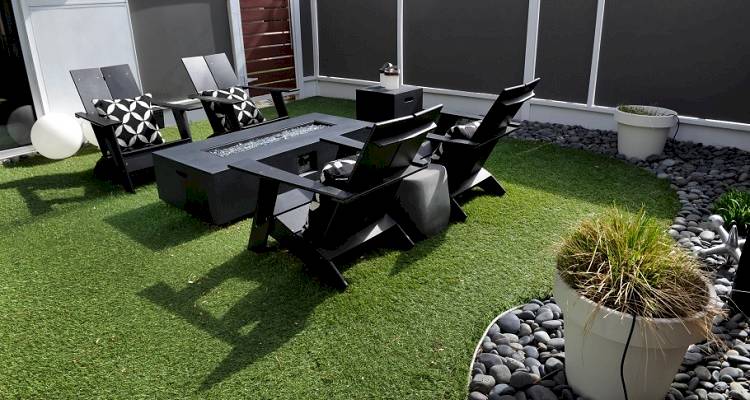
Invented by the notorious chemical company Monsanto, "ChemGrass" (as it was known), was first used in 1966 for sporting stadiums in the USA. Later rebranded AstroTurf the name quickly became the generic term for almost all artificial grass.
Since its creation, artificial grass has evolved through three main generations: from the first system being constructed of short-pile fibres without infill, through longer fibres and a sand infill of the second generation, to rubber/sand mixed infill and realistic multi-length fibres of the third generation commonly available today.
Is it possible to have an indoor lawn?
These days, it would be so much easier to get artificial turf that needs no daylight, water, or mowing. If you pay for the premium type, you could use it for bowls with no worries at all."
What Are the Benefits of Artificial Grass?
Green, lush, and uniform lawns are often the first image which comes to mind when dreaming of how you wish your garden to look. The perfect garden grass is so desirable that neighbours commonly compare other lawns to see who has the best-looking gardens.
From mowing, trimming and weeding, to aerating, fertilising, and cleaning, having a beautiful lawn will more often than not create the homeowner a lot of work.
To reduce this workload and increase the time available to enjoy their lawns, it has become increasingly common for homeowners to turn to artificial lawns.
So, what makes an artificial lawn so appealing? Why is it worth the initial high price?
- No Need to Water - Real grass needs watering, especially in dry months—sometimes twice a day, whereas artificial grass only needs occasional cleaning with a hose.
- No Need to Cut/Mow - Artificial grass doesn’t grow, eliminating the need to mow or the requirement of buying and maintaining a lawnmower.
- No Need to Pull Weeds - Real lawns attract common weeds like daisies and dandelions. Artificial grass prevents weed growth and requires minimal weeding.
- No Need for Chemicals - Fake grass doesn’t need fertilisers or pesticides, this saves money and promotes a safer eco-friendly garden environment.
- Looks Great All Year Round - Stays green and attractive in all seasons, regardless of weather, with modern artifical grass looking very realistic compared to a genuine lawn.
How can I turn my garden into a low-maintenance garden? I don’t have the energy these days to keep up with all of the cutting/weeding/trimming involved. I want a nice garden that has minimal upkeep.
How to Install Artificial Grass
Saving money is often the reason the majority of people consider DIY tasks. However, when it comes to laying artificial grass, labour costs are not the biggest expense.
In fact, the grass itself, the equipment it takes to install, and the time it takes for an unskilled person to lay will quickly increase a budget past the amount often charged by a professional.
If, however, you are the DIY type of person who just has to be self-sufficient, then it is possible to undertake the project yourself.
For step by step guide on how to install artificial grass, check out our guide here.
Tools Needed To Install Artificial Grass
The tools required to lay artificial grass can be as simple or complicated as you like; with a little as a spade, Stanley knife, and tape measure, you can often fix most styles of grass.
However, for a large garden space or for those with a taste for gadgets, turf removers, whacker-plates, and power brushes are all available for hire to help you perform the laying work.
If you do choose to hire equipment, hire companies usually offer deals and discounts with complete jobs in mind. For example, they can often offer a turf remover, whacker-plate, and power-brush, as a joint hire for a discounted amount when compared to hiring them separately.
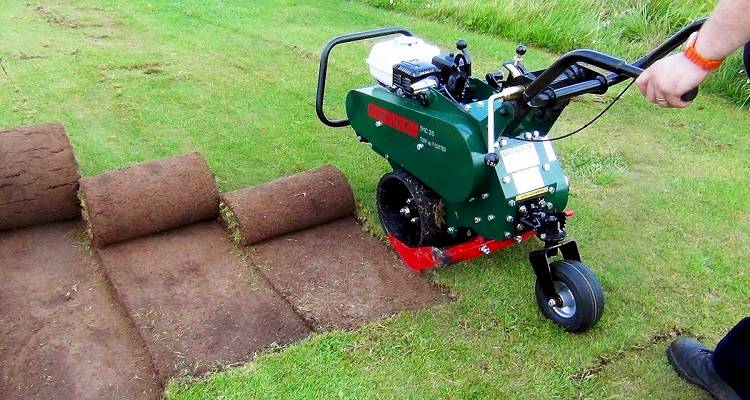
This will often cost around £100 per day jointly and £50 per item is separate. As a result, this can quickly cost just as much as hiring a professional to perform the task for you. Not to mention the hours of your own time you will need to spend actually undertaking the work itself.
Safety Equipment Needed To Install Artificial Grass
Also, a concern that should never be overlooked is safety gear. If you do not have the required safety glasses (£10), gloves (£5), a good set of overalls (£25), and safety shoes (£25), these will also need to be purchased when using hired power tools.
Whacker-plates, power brushes, and turf removers are all extremely dangerous tools if they are not handled correctly. However, even the basics of a spade and Stanley knife can cause bad injuries if particular care is not taken when using them.
What Type of Artificial Grass Should I Use?
There are three main types of artificial grass materials on the market today. Each type has its own advantages and disadvantages. For example, the nylon types are more suited to commercial use, and the other two (polypropylene and polyethylene) are designed with more of the residential market in mind.
| Advantages | Nylon | Polypropylene | Polyethylene |
|---|---|---|---|
| Inexpensive Styles Available | X | ✔ | ✔ |
| UV Resistant | ✔ | X | ✔ |
| Large Variety of Styles | ✔ | X | ✔ |
| Weather Resistant | ✔ | X | ✔ |
| Moderately Realistic Appearance | ✔ | ✔ | ✔ |
| Ultra Realistic Appearance | X | X | ✔ |
| Large Variety of Styles | ✔ | X | ✔ |
| Hard Wearing | ✔ | X | X |
| Water Resistant | ✔ | ✔ | ✔ |
| Plastic Base | ✔ | ✔ | ✔ |
| Sand Base | ✔ | X | ✔ |
| Woven Base | X | X | ✔ |
| Disadvantages | Nylon | Polypropylene | Polyethylene |
|---|---|---|---|
| Expensive Styles Available | ✓ | X | ✓ |
| Prone to UV Damage | X | ✓ | X |
| Prone to Weather Damage | X | ✓ | X |
| Moderately Fake Appearance | ✓ | ✓ | X |
| Fake Plastic Feel | ✓ | ✓ | X |
| Prone to Abrasive Damage | X | ✓ | ✓ |
Recommended Usage
| Disadvantages | Nylon | Polypropylene | Polyethylene |
|---|---|---|---|
| Small Gardens | X | ✓ | ✓ |
| Medium Gardens | ✓ | ✓ | ✓ |
| Large Gardens | ✓ | X | ✓ |
| Commercial Use | ✓ | X | X |
Artificial Grass Alternatives
There are obvious alternatives to using artificial grass, the first being real grass. However, there are also options such as decking, gravel, concrete, and patio paving.
Each option will have its various costs associated with it, along with pros and cons for each choice.
Patio Laying Cost
Having a part of your garden as a patio area is extremely common in the UK. However, having a medium or larger garden entirely covered with a patio can make the space look unwelcoming and uncomfortable.
The cost of laying a patio that covers an entire medium garden (70m²) with paving will often exceed £3,000. This is due in part to the paving material being an expensive option and also often requiring a professional tradesman (such as a landscaper) to install the patio over several days.
The advantages of patio paving are its obvious hardwearing nature, long-lasting weather-resistant finish, and aesthetic appeal (over a small area).
The disadvantages of patio paving are the expensive costs for installation and materials, the lack of flexibility in the final design, the skills it takes for installation, and only really being suitable for a small garden or section of a larger property.
Decking Cost
Decking is a plank covering often used in a garden within an elevated area. Consisting of a wooden frame with laid planks attached to form a consistent covering, decking is usually finished with paint or wood stain or made out of composite.
The advantages of using decking are the cost-effective options available. Decking costs between at around £200 per 10m² area — with multiple styles and materials available to get the final design that you want.
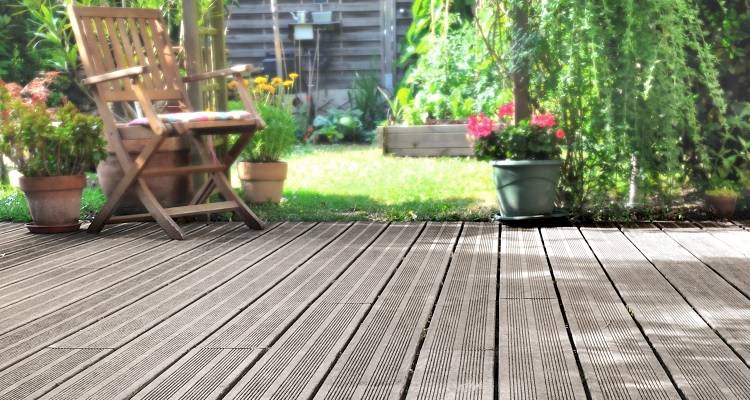
The disadvantages of decking are the complexity of construction, needing a tradesman to build, the price of materials (costing around £20 per m²) depending on the material chosen, and most importantly, the maintenance required to keep it looking clean and tidy.
Gravel
Gravel is a small to medium coarse stone infill, which is extremely common for driveways. Costing around £60 to £85 per ton, it is by far the cheapest option for any outside space covering.
The advantages of gravel, beyond its low price, are the simplistic maintenance required, the ease of installation, and the variety of colours and shapes available.
The disadvantages of using gravel are the lack of aesthetic appeal with the finished product, the attraction of animals/pests, over time the stones get misplaced in areas, and also gravel can quickly look worn out.
Maintaining and Repairing Artificial Grass
If you like the idea of having a beautifully lush and green lawn with little worry about how to look after it, then an artificial lawn is often the best option. You don't have to worry about changes in the weather, insects and pests infesting your garden, and even bold spots appearing due to pet usage.
Maintenance
There is no need to water an artificial lawn, cut it, or spend vast amounts of money on weed killers and pest control.
To keep your artificial lawn in perfect tip-top condition, all you need to do is simply run a small amount of water through it once per week to remove any unwanted dirt, and occasionally sweep it with a stiff bristled broom (costing around £7) in order to fluff it up, if it should require it.
Repairs
Even though fake grass lawns are extremely durable and not easily damaged, it is actually possible for the lawn to be damaged in a few ways. However, the good news is that it is often a very easy solution to repair the damage and return the lawn to its former glory.
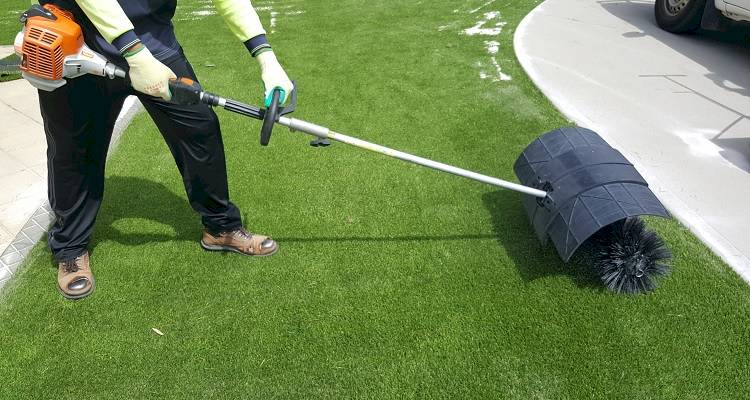
Flattened Grass
Over time and with constant high-traffic use, most (if not all) types of grass, both artificial and real, can become flattened and sorry-looking.
Thankfully, when dealing with artificial turf, the solution is quite simple: to brush the fibres with a broom. This will, in turn, fluff the grass blades back into their original positions and return the grass to looking fluffy, lush, and beautiful again.
Loose Sections
Sections becoming loose or moving under usage are often caused by incorrectly fitted grass. To solve this problem, simply lift the movable pieces, re-join the seams, and re-pin or bond the patches to the surface.
Patching and Replacing Ripped or Damaged Sections
Sharp objects, excessive heat, and harsh chemicals can all damage your newly installed artificial lawn. If a section (or patch) is damaged, these areas can be fixed by replacing the damaged turf with new turf using glue or tape to join the pieces together.
The important consideration with this style of repair is to find the correctly matching replacement piece of turf to your existing style of turf on your property. This is why it is often good practice to keep off-cuts when installing an artificial lawn and even order a little extra for future repairs.
What can I do to prolong the performance of my artificial grass?
What is the Best Time of Year to Install Artificial Grass?
When you wish to plant a real grass lawn, there is a very strict time scale for the actual installation. Outside of the spring months, real grass will have an extremely slow and difficult time growing well. Artificial grass, however, does not suffer from such issues. You can actually install fake grass lawns at any time of year.
Generally, however, artificial grass is best laid during colder months as the ground is softer, and this makes the process easier. It is best practice to wait until the outside temperature is around 15 to 10 degrees Celsius, and there are no high winds.
Even though these conditions will provide the very best environment to install your new lawn, it is not a necessity to installation. If it happens to be spring or summer and you wish to go ahead and have the new lawn fitted, it is still possible to successfully do so.
Laying an artificial lawn in the hotter, drier months may cost a little more, as with the ground being harder and more difficult to work with, the whole process may take a little longer.
So, for a medium 70m² garden, instead of taking 2 to 3 days to fit the lawn, it may take 3 to 4 days to fully complete. This in turn would add around £100 to £200 to the initial labour budget.
Is Artificial Grass Bad for the Environment?
In the modern day, personal environmental impact will often play on the minds of a lot of people. How does your life impact the earth and nature around you? Well, a common misconception is that artificial grass is bad for the environment.
In fact, artificial turf is extremely friendly to the environment. With the recent increase in safety standards and global safeguards (DIN 18035-7), the production of artificial grass is now heavily regulated to ensure that there are no harmful plasticisers or heavy metals in the construction.
Most importantly, a natural grass lawn will use a lot of fertilisers and pesticides to keep it lush and beautiful looking, whereas an artificial lawn does not require these chemicals. This, in turn, keeps the local environment free from such harmful products.
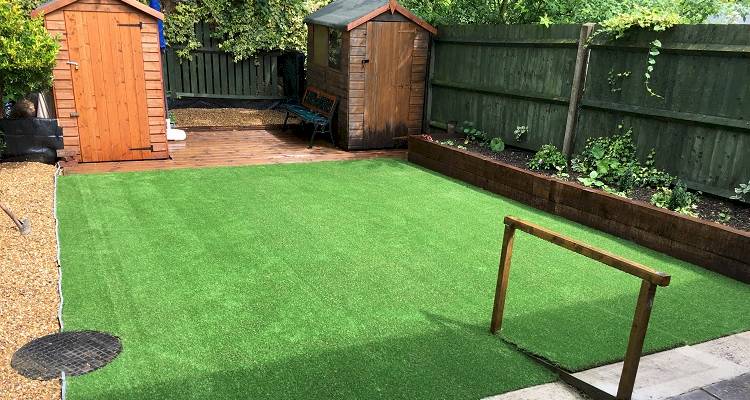
An artificial lawn also does not require the use of electric or high-polluting petrol lawnmowers in order to maintain it. This means they have zero energy costs and zero emissions. During droughts and hose pipe bans, an artificial lawn will stay green and well-kept, unlike its natural counterpart.
Finally, there are various varieties of artificial lawns which are constructed from recycled materials (such as plastic bottles and bags). These "eco-lawns" are, therefore, helping to remove waste from the environment and repurpose plastic materials before they are sent to landfills.
Cost of Artificial Grass Removal
There can be various reasons to want to remove your artificial lawn - maybe it needs replacing with a brand-new different style of grass, maybe you wish to go back to real grass, or maybe you have decided to patio the area.
Regardless of the reason for removal, taking up your "AstroTurf" lawn can be a difficult process if not done properly.
When removing your turf, you should try to find the seams. This can be difficult as, when laid properly, these joins can blend perfectly together. If you are unable to find the seams, do not worry, just locate one of the corners and begin there.
The first thing to do is take a sharp Stanley knife and cut a hand-sized hole by the edge of a seam or corner to provide you with a place to grip. Once the initial cut has been made, slice the turf along its full length, being careful to cut through the entire depth of the sheet.
Next, you will need to cut along the widths of the slices, creating manageable-sized squares, which can then be easily pulled up with a little force. If the lawn was bonded with a two-part glue to a hard surface, this may prove harder to remove than if pinned to soft ground.
If you do not wish to undertake this job yourself, however, then you may want to hire a landscaper, or even the original installer, to remove it for you. Removal of artificial lawns should take around the same length of time as it took to install.
Therefore, the cost for labour will be around the same as you originally paid (if you use the same contractor). A good rule of thumb is that it will take on average 1 day per 50m² of lawn removed. As a result, for an average 70m² garden, it will take approximately 2 days to complete and cost £200 to £300 in labour.
Whether you hire a tradesman or decide on the DIY route, you will more than likely need to worry about waste disposal. The disposal of any waste created during the removal process can usually be discarded into a skip. Skip hire will usually cost around £200 to £250 for a single skip, hired for a week, with pick-up and disposal.
Depending on the size of the lawn being removed, this may not be large enough for a larger garden lawn measuring over 150m², and you may need to either hire a second skip, a larger skip, or even just have the original emptied when filled then returned (average £50 each time).
Checklist: Hiring an Artificial Grass Installer
- Qualifications – Depending on if you are choosing to hire a landscaper, there are a few forms of qualifications to look for in the form of CSCS certification, City and Guild levels, or even college gained qualifications such as HNC’s. However, since the application of artificial grass has only just started to become popular within the residential marketplace, there are few specific qualifications that relate directly to artificial grass.
- Equipment - An important consideration before hiring any tradesmen for the project is to check they possess the correct equipment. If they need to hire tools, such as a whacker-plate, power brush, etc, this will increase the price and have to come off of your budget.
- Insurance – The most important consideration when hiring any tradesman is the insurance. Make sure they possess, at the least, third-party liability, which covers work undertaken. At best, you want to find a tradesman, which has personal injury, property damage, and work guarantee cover.
- Previous Experience – Evidence of previous work is also a good consideration when hiring any tradesman. If they have references from previous clients, photos, or a portfolio of their work, it will prove they are proud of the level of skill they can provide. This is especially important when it comes to artificial grass laying, as many tradesmen may not have had such a wealth of experience with the material.
- Guarantees – Does the tradesman offer any form of guarantee for the work they are going to undertake? Most will offer in some form or another to make sure you are happy with the job before they finish. However, it can be worth looking for a tradesman who offers a 5-year guarantee or greater. Then, if any problems arise in the future due to any faults in the installation process, you are covered, and they will fix their mistakes at no expense to you.



